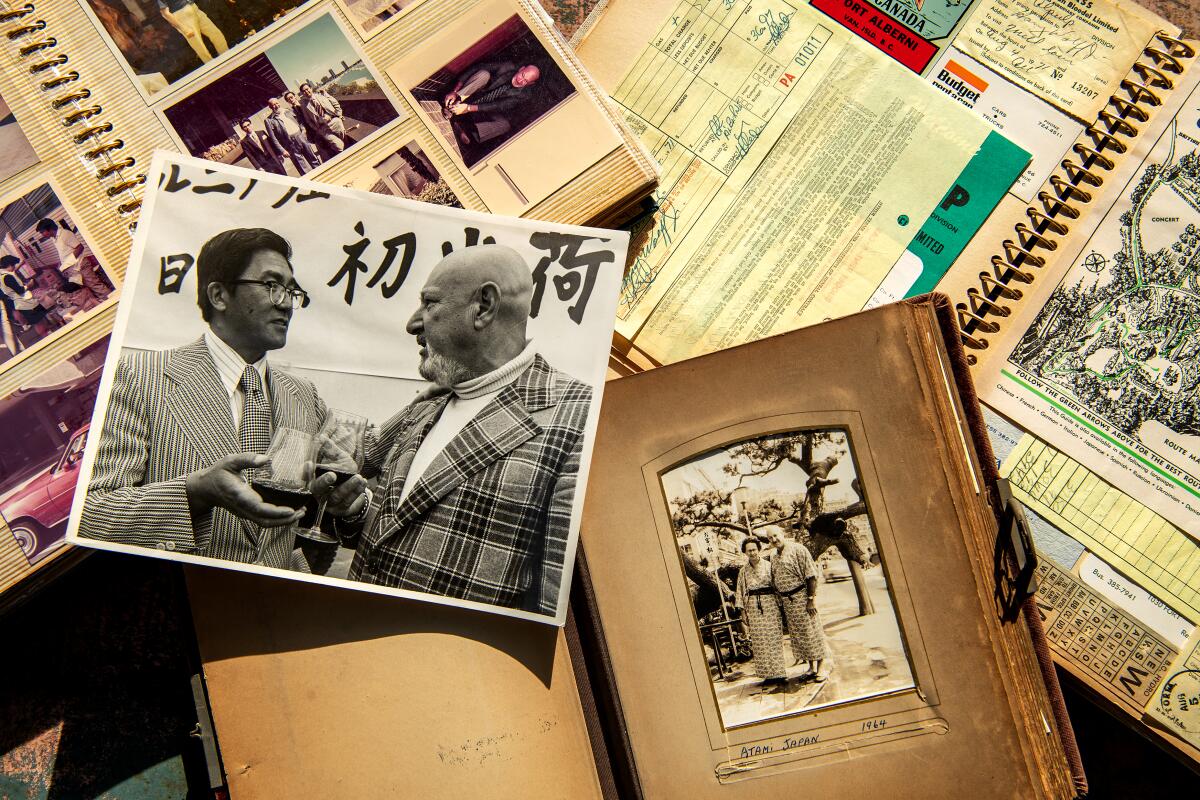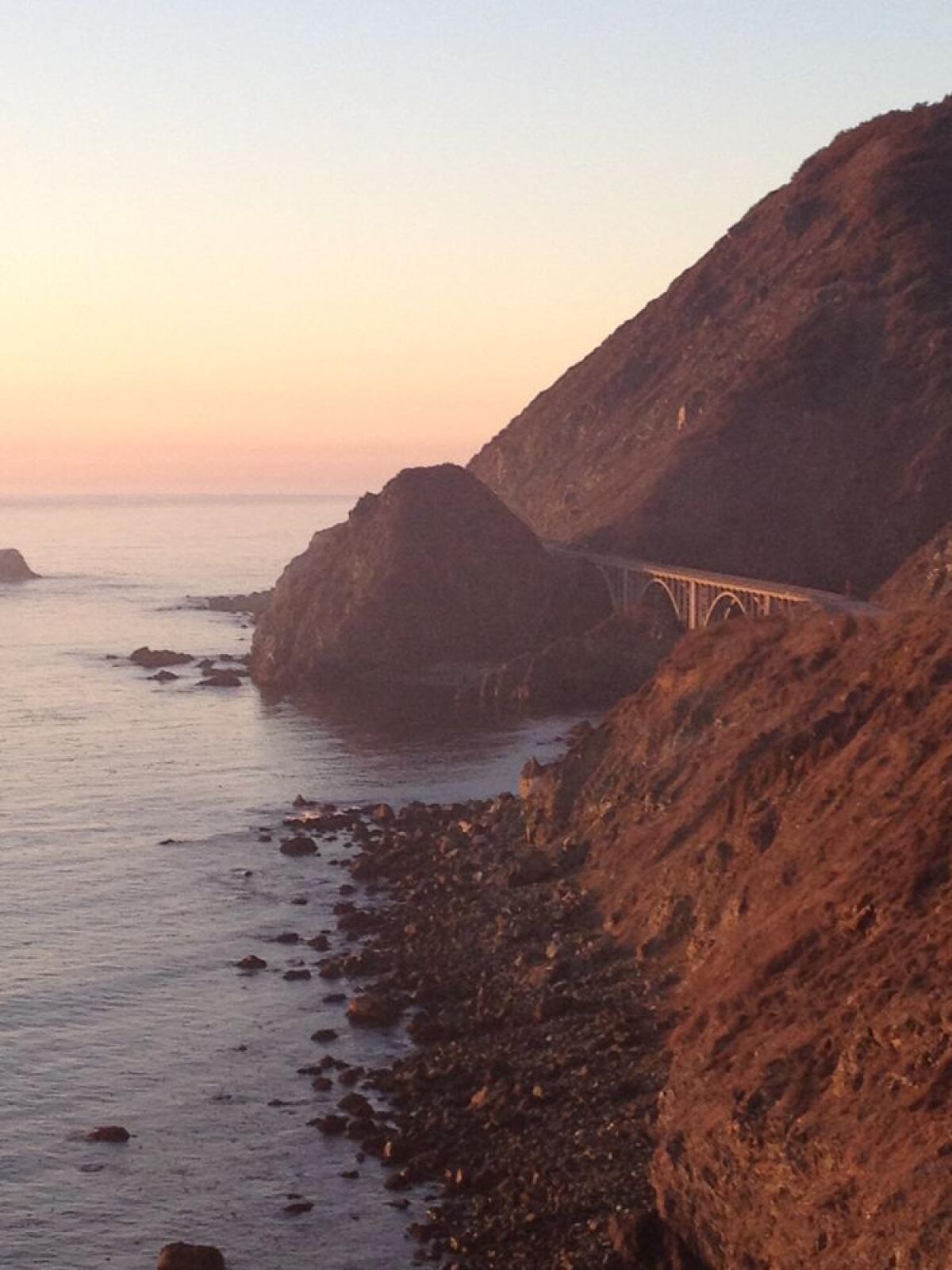The delicious story of how L.A. helped bring sushi to California and beyond

- Share via
Good morning, and welcome to the Essential California newsletter. It’s Monday, May 8. I’m Laura Blasey, assistant editor for newsletters at The Times.
Most of the time, you’ll find me behind the scenes, editing Ryan Fonseca’s work, reading your emails and keeping the little slice of internet we call Essential California running smoothly. Today, however, I’m coming to you directly to talk about sushi — specifically, the story of L.A.’s delicious role in the industry’s American boom, which is part of a larger Times project. It’s a story of friendship, cultural exchange, innovation and, of course, food that brought two people together, even if it ultimately broke them apart.
Full disclosure: I was hungry when I picked this project to highlight. But perhaps you will be, too, when you finish reading. Maybe you’ll even place a takeout order from your favorite restaurant.
These days, sushi isn’t hard to find in L.A. There are nearly a dozen Sugarfish locations. The city boasts eight Michelin-starred sushi restaurants. Then there are your smaller neighborhood spots offering traditional rolls and unique spins, like the vegan tasting menu I recently tried at a spot in Culver City. I’ve never been to Nobu, but I’ve read enough celebrity gossip to feel like I have.
It wasn’t always that way. Even as Los Angeles’ cultural significance blossomed in the 1950s and ’60s, the city’s food scene remained decidedly homogeneous — meatloaf at your local dive, French cuisine if you were feeling fancy. The few Japanese restaurants that did open during this time catered to an American palate, my colleague Daniel Miller writes in a new piece. Sushi wasn’t unheard of, but it wasn’t Tokyo-style nigiri — the mounds of rice draped with delicate slices of mostly raw fish we know today.
As Miller tells it, our story begins in Tokyo 1965. The setting: a family-run spot in the Ginza district called Shinnosuke. The mood: stressed and a little downbeat.
Noritoshi Kanai, who managed an L.A. wholesaler of Japanese food products, was visiting the city with his friend and consultant Harry Wolff Jr. in hopes of finding a new product to introduce to customers in California. Kanai’s early bets had been so successful, other companies had begun to import the same cookies and crackers and cut into his profits.
The pair went out to dinner, inspiration running low, and Kanai chose a spot he knew Wolff would enjoy. For his open-minded palate, Wolff had a distinctly American upbringing. Daniel describes him as an imposing Jewish man who’d cut his teeth as a bouncer in his native Chicago before he found a talent for salesmanship and became a unique partner to Kanai, a trim Japanese man who’d served in the Japanese army.
And enjoy it Wolff did: Daniel reports that when Kanai received a bill from the restaurant to his office a few days later, he was shocked by the figure — the equivalent of nearly $2,650 today. Wolff had enjoyed the plates of nigiri so much, he had been slipping away to feast in secret for days. And as he told Kanai, he suspected other Americans would love it, too. Daniel writes:
“An ambitious plan soon took shape. Mutual Trading would import the ingredients and implements needed to serve sushi here — from the nori to the knives.”
The timing couldn’t have been better for the pair: Recent innovations in shipping allowed them to safely import fish from Japan while a Japanese immigrant in California’s Central Valley had developed a new strain of medium-grain rice, inspired by what was available in Japan and perfect for sushi.
The final challenge, Daniel writes, was getting a restaurant in L.A. to sell sushi. The pair went for Little Tokyo’s Kawafuku — an influential spot that had opened in 1923 and hosted the city’s biggest names in entertainment, sports and politics.
Kawafuku’s sushi bar opened around 1965, and as Wolff had predicted, it was a hit. Other eateries in Little Tokyo added their own, and sushi’s popularity spread from there.
California sushi chefs began to innovate even further in the following years — you can thank them for sushi boats and the California roll.
For all the success that Kanai and Wolff’s idea generated, it also brought strain to their relationship. Wolff advised Kanai on commission, but as family told Daniel, the two men couldn’t agree on new terms during a renegotiation. Wolff walked away from the business and they never spoke again. Details on the abrupt break-up are sparse. Wolff died in 1996 and Kanai in 2017.
Read Daniel’s story here: “How two friends sparked L.A.’s sushi obsession — and changed the way America eats.”
That’s just a taste of what there is to know about Los Angeles sushi. Here are a few other pieces from The Times’ food team that I enjoyed:
- What makes L.A.’s sushi scene so great? Restaurant critic Bill Addison found answers in Tokyo.
- How Koda Farms created the perfect sushi rice in California’s Central Valley.
- This Little Tokyo restaurant is long gone. But it changed L.A.’s food scene forever.
- Los Angeles is the epicenter of sushi in America. Here’s where — and how — to find the best.
And now, here’s what’s happening across California:
Note: Some of the sites we link to may limit the number of stories you can access without subscribing.
L.A. STORIES
Should we call it a turf war? Bryan Michael Stoller had to do a double-take when he stepped outside his Studio City front door to walk his dog and saw a strip of bare earth. Thieves had made off with about 30 feet of artificial turf while he slept. And if the crime sounds odd, trying to warn others got just as weird. Los Angeles Times
Check out "The Times" podcast for essential news and more
These days, waking up to current events can be, well, daunting. If you’re seeking a more balanced news diet, “The Times” podcast is for you. Gustavo Arellano, along with a diverse set of reporters from the award-winning L.A. Times newsroom, delivers the most interesting stories from the Los Angeles Times every Monday, Wednesday and Friday. Listen and subscribe wherever you get your podcasts.
POLITICS AND GOVERNMENT
Restrictive border policy Title 42 ends this week, leaving an imprint on the future of asylum. The policy relied on pandemic public health orders and was used to block asylum seekers and other migrants from entering the United States. But though the orders are now expiring, Title 42’s effects will likely remain, including a large backlog of asylum seekers. Los Angeles Times
You may remember Ryan’s December interview with Kamilah Moore, chair of California’s Reparations Task Force. The group voted on Saturday to recommend that the state issue a formal apology for slavery and potentially provide billions of dollars in cash payments. Here’s what that means. Los Angeles Times
CRIME, COURTS AND POLICING
Cannabis workers face death and exploitation. Acknowledging growing concern over mistreatment, California regulators have quietly assembled a team to pursue cannabis labor exploitation in the state’s burgeoning weed industry following a Times investigation. Los Angeles Times
A series of stabbings, two of them fatal, shook the sense of community in Davis, Calif., residents say. Police arrested Carlos Reales Dominguez, a former student at UC Davis, in connection with the stabbings. Dominguez pleaded not guilty. Sacramento Bee
Weeks after a cyberattack crippled the San Bernardino County Sheriff’s Department computer systems, county officials confirmed that the hackers had been paid a $1.1-million ransom. The ransomware attack, discovered in early April, forced the department to temporarily shut down some of its computer systems, including email, in-car computers and some databases. Los Angeles Times
Support our journalism
HEALTH AND THE ENVIRONMENT

This tribe was barred from cultural burning for decades — then a fire hit their community. Many experts point to a lack of regular, low-intensity fire that has caused wildfires in some California ecosystems to grow larger and more severe. And, in a cruel irony, Native Americans are among those most affected, they say. Los Angeles Times
CALIFORNIA CULTURE
Experts say the impact of the current writers’ strike could surpass the 2007 work stoppage, which led consumers to spend less at shops and restaurants — even car dealerships took a hit. The cascading effects this time around could touch almost every facet of the economy in Southern California, including the housing market, and lead to economic fallout. Los Angeles Times
They’re all good boys, but one Sonoma County dog hopes to be crowned the best boy. Rafa, a 2-year-old, 100-pound Tibetan mastiff from Sonoma, is headed to the massive stage of the Westminster Kennel Club Dog Show this week. “It’s kind of like watching your kids compete in sports,” his owner said. “And now he’s going to the World Series.” Santa Rosa Press Democrat
Free online games
Get our free daily crossword puzzle, sudoku, word search and arcade games in our new game center at latimes.com/games.
AND FINALLY
Today’s California memory is from Laura Shamas of Pacific Palisades, Calif., who nominates Big Creek Bridge in Big Sur, Calif.

Laura writes:
“My husband and I love to drive Highway 1 on the Central Coast because it’s so spectacular. We try to do it once a year (when it’s open). Nine years ago, on a January day, I got a sunset photo of Big Creek Bridge on Highway 1, near the Big Sur area. The bridges on Highway 1 from Ragged Point to Monterey always amaze us — true feats of engineering.”
If you have a memory or story about the Golden State, share it with us. (Please keep your story to 100 words.)
Please let us know what we can do to make this newsletter more useful to you. Send comments to essentialcalifornia@latimes.com.
Sign up for Essential California
The most important California stories and recommendations in your inbox every morning.
You may occasionally receive promotional content from the Los Angeles Times.



